Border Duty Commemorative Posters - Wall Stuff
The history of commemorative
Border Duty Certificates and Daley Barracks has been a
difficult story to unsort with any degree of certainty.
There were periods when they were not given out, the designs
and standards to receive the award changed over the years
and there are some very big gaps in the story. For what
should have been the most frequently found memento of
service on the border, we have surprisingly few images. Who
were the first men to receive such certificates and who was
the last Eaglehorse trooper to take this souvenir home?
| |
 |
|
| |
John Puagh’s 2/14 ACR Border Certificate from 1960. --John Puagh |
|
The very earliest reference
found to border related certificates and our region of the
Rhoen are messages left on various Internet Cold War message
boards by a woman named Dena Houston. She was looking for
people who knew her father and states in part, that in her
possession is her father‘s “ Border Legion “ certificate
from when he was a member of the 24th
Constabulary Squadron. Contact with this woman and an image
of that certificate have been very difficult to come by.
In first talking with
veterans on this subject, the impression was that no border
related certificates for cavalry troops existed until well
into the 1960s. Certainly none of the troopers who had
contributed to this site with service dating to the very
early days recall any type of border commemorative souvenir.
Then an e mail appeared from John Paugh with an attachment
showing his 1960 2nd Battalion - 14th
Armored Cavalry Regiment presentation certificate. John
couldn’t recall many specifics beyond receiving the
certificate at the end of his tour. LTC ( Ret ) Ray Teel
also sent a copy of his certificate from 1962 and it shows
the tradition and design had remained consistent for a few
years. Ray also noted:
| |
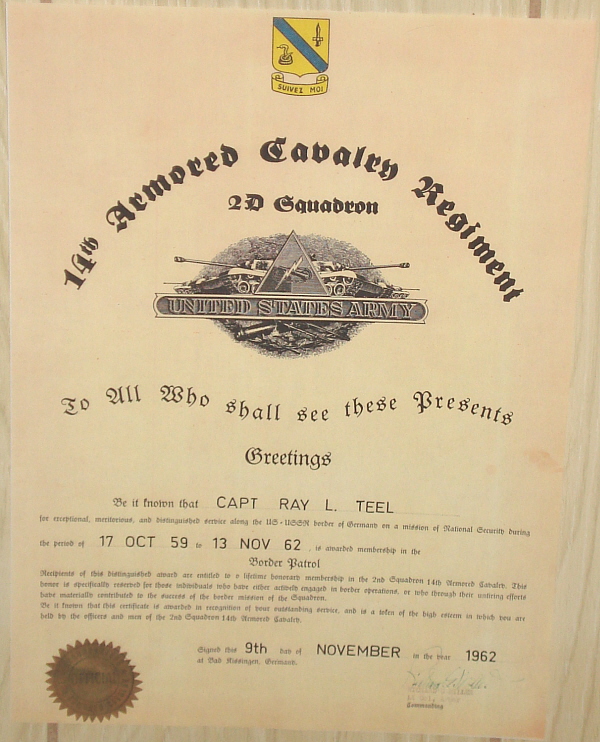 |
|
| |
Ray Teel’s certificate from a few years later. --Ray Teel |
|
My recollection is that
all three squadrons used the same design, just the lettering
changed from Fulda to BK to Hersfeld. At Daley, it was up to
the Troop - Company commander and I think almost all
troopers got a certificate if they had been good soldiers.
Up at Regiment, they had some sort of very ornate
certificate for VIPs.-
Although the German border
had been a concern since the early 1950s, it reached a
higher public consciousness once the barriers became more
visible and particularly after the Berlin crisis and
President Kennedy’s visit to that city. The next example of
a certificate I have seen is from the First Squadron - 14th
ACR. This impressive document, 19.5 by 12.5 inches, was
signed in 1968 by SCO Theron Knapp. The design had changed
and troopers at Fulda received a poster showing the border
towns in the 1st Squadron sector and an ominous
stretch of barbed wire. This design was somewhat similar to
the image of the 2/14 ACR certificate John Saunders received
just prior to the re - flagging of the Regiment.
| |
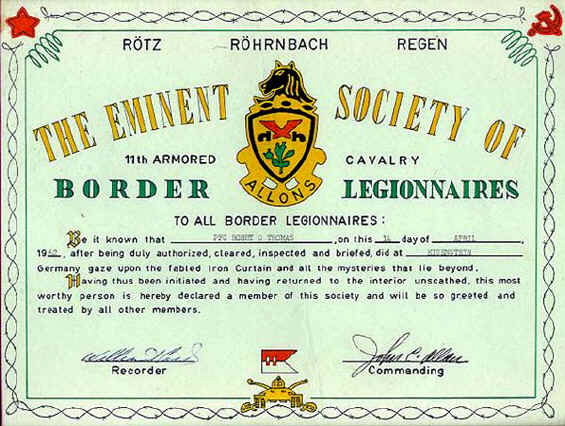 |
|
| |
Border Legionnaires Certificate from the 11th ACR on the Czech
border in the early 1960s. Image collected by Ted Prescott at
Grenzer web site. --Ted Prescott |
|
BG ( Ret ) Mike O’Connell,
who was the SCO when the re - flag occurred in May 1972 and
then commanded the Eaglehorse for the next fourteen months
did not recall the tradition of certificates and the
Blackhorse. In very few words - if certificates were given
out, he’d of had one … and he does not.
When I arrived in 1978, the
Eaglehorse squadron had a great looking certificate based on
the Bavarian Border Police Grenz Tafel ( border poster )
that was displayed every 100 meters or so on the West German
side. The poster showed all the key border features one
could expect to see and made it perfectly clear that the
metal fence was NOT the border, but rather the imaginary
line marked by the blue and white plastic poles. For cavalry
presentation use, the German text had been removed and in
its place, room for the usual boiler plate, “ Trooper XYZ,
having served with distinction on the Frontier of Freedom,
from dates … “ and then the signature block for the Squadron
Commander.
| |
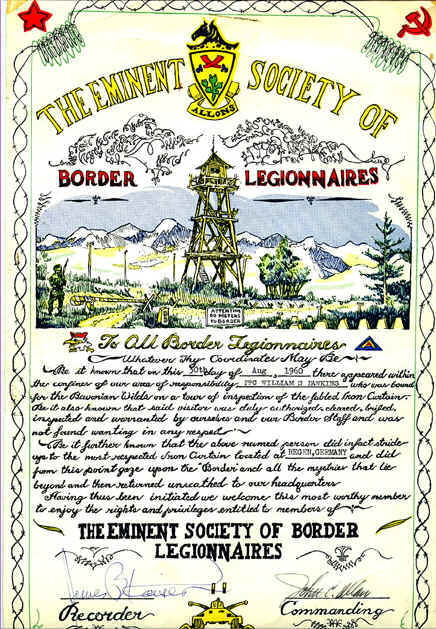 |
|
| |
A second version of a spectacular 11th ACR early 1960s certificate
from Ted Prescott’s digital collection. --Ted Prescott |
|
I also recall that only
those troopers who had actually gone to Camp Wollbach - Camp
Lee qualified for the certificate, this excluded the
majority of HHT. By 1981, I believe that restriction had
been lifted and all troopers who finished their tour in Bad
Kissingen in good order received a border certificate. The
squadron draftsman from the S3 shop did the calligraphy and
specially ornate copies were produced as souvenirs for
visiting dignitaries. There may have been some talk about
the certificate undergoing a major redesign shortly before I
departed Bad Kissingen in 1981. Going into the mid 1980s,
Ted Prescott’s border certificate indicates the design had
remained consistent.
| |
 |
|
| |
2/14 ACR 1962 certificate to Peggy Teel certifying that she is now a
“ Frontier Girl “ in good standing. --Stefanowicz |
|
When the last certificates
were awarded at Daley Barracks and who was the last
Eaglehorse trooper to receive a border certificate are great
questions to which I do not have a satisfactory answer. Once
the squadron left BK, was basically done with the border and
moved to Wildflecken, did some sort of certificate tradition
carry on? Is there an ultra rare Eaglehorse at WTA
certificate? I cannot answer these questions until someone
steps forward from that era to clarify the situation.
Considering that we all were tasked to be scouts, the
reporting in this area has been less than sufficient.
The final issue to explore
on this topic are the “ new “ border certificates currently
being marketed on E Bay. More than one enterprising trooper
has cobbled together out of scans and clip art, certificates
for both the 2nd ACR and the 11th ACR
recalling border duty. If you have lost your original, this
is one alternative … these reproductions appear to look
something like the originals, in a small scale … but if you
really want a certificate like that looks like the one you
lost or that became water damaged … keep up on the net,
Randy and I are formulating a plan.
| |
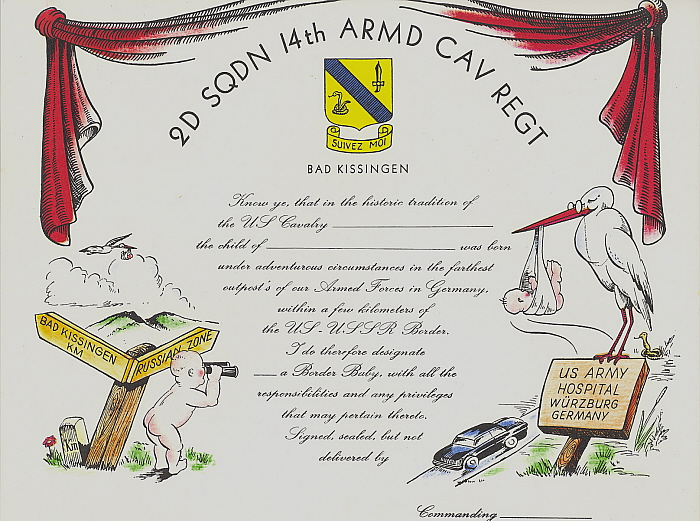 |
|
| |
2/14 ACR Border Baby Certificate from same period. --Stefanowicz |
|
Returning to original
certificates, if you can take a clear photo of your Border
Certificate or similar memento from your service in Bad
Kissingen and send it to the web site, we will gladly add it
to the article. This includes certificates marking the birth
of children or honoring military wives. If anyone knows
about the last certificates awarded to Eaglehorse troopers,
it would make a great way to wrap up this chapter of cavalry
history. Please do not keep it to yourself.
Order of the Spur - The
Cavalry Platoon Leader’s Night Ride - More Wall Stuff
One great trend Army wide
starting in the mid 1970s was the application of measurable
standards to virtually all aspects of the duty day. SQT
measured individual trooper skills within his MOS and
appropriate to his grade. The ARTEP measured all the
collective tasks necessary for a platoon / troop / squadron
to be an effective fighting force. Training for both the
individual and the unit was based on understandable goals
that could be measured. Everywhere one looked, it was task
-- condition -- standard. In the mid 1970s, however, one
small tradition had not yet been brought into the system,
the Order of the Spur.
| |
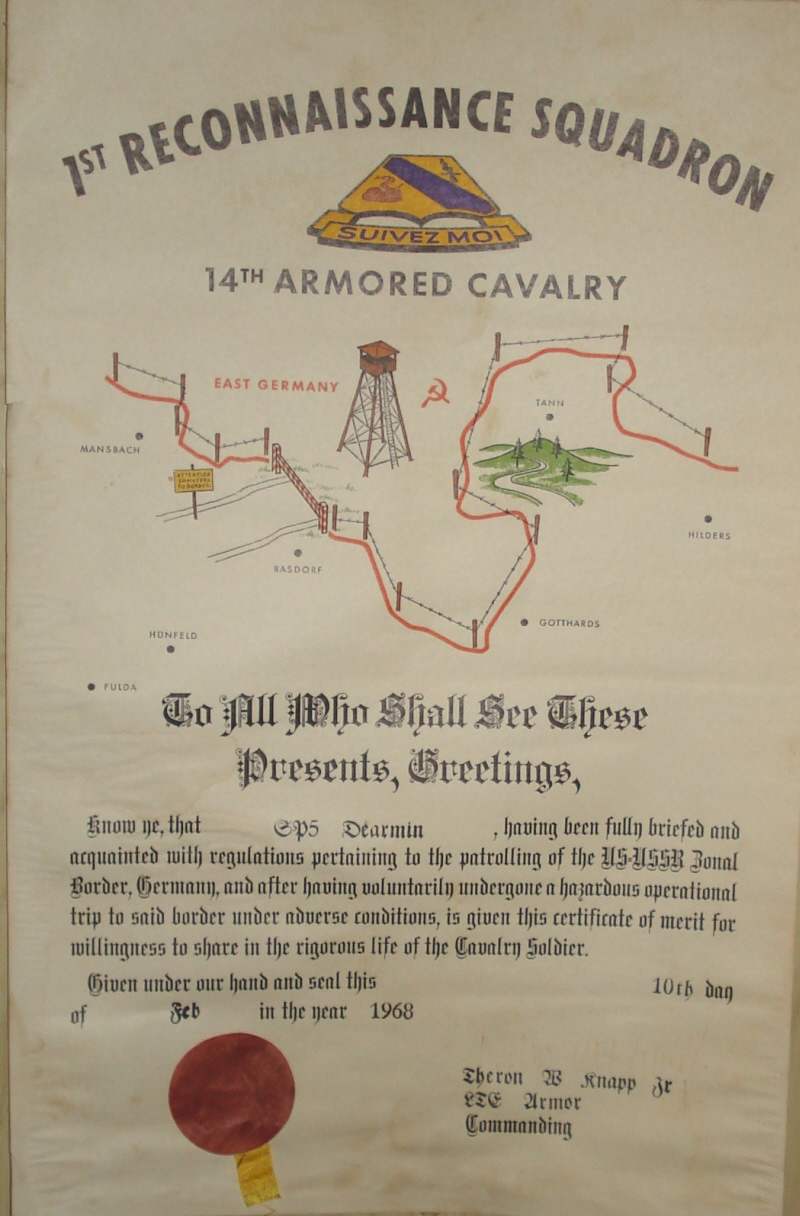 |
|
| |
1/14 ACR Certificate as of 1968. --Stefanowicz |
|
I guess it’s just in the
genes, give a U.S. cavalry trooper ˝ a chance and he will
start monkeying with his uniform to pay tribute to the horse
soldiers of the past. All of this flew in the face of
uniform standardization, brought on by then Army Chief of
Staff Bernard W. Rogers. Starting in 1979, troopers bid
adieu to their berets, oversize brass belt buckles and
Stetson hats. The only locally sanctioned exception in the
Blackhorse was afforded to officers at two types of formal
functions: Regimental Dining In ( formal meal - wives
excluded ) or Regimental Dining Out ( wives included ). I
recall two or three of these events were held per year.
Along with berets and later,
Stetson hats, many officers could be seen wearing silvered
spurs on their low quarters at these memorable chicken
dinners featuring occasional fights, bouts, contests and
alcohol fueled feats of strength. The spurs indicated that
the officer had been awarded the Order of the Spur,
requirements set forth by the Regimental Commanding Officer.
More than one officer entered the formal function with his
spurs pointing to the exit and departed … some hours later,
with his spurs pointed to the floor.
| |
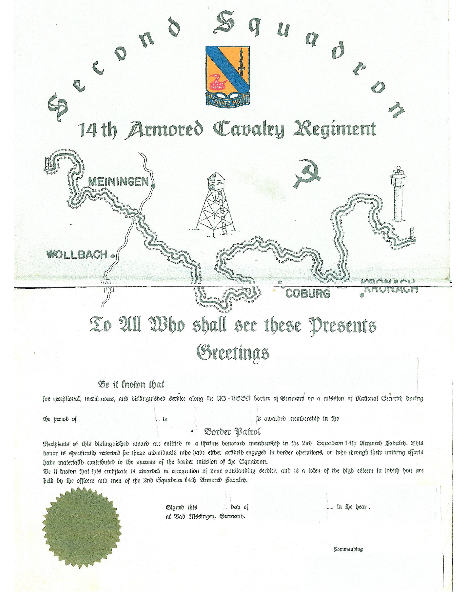 |
|
| |
2/14 ACR Border Certificate as of 1971. --Scoot Saunders |
|
If an officer had
successfully acquitted himself in his assigned duty for a
full training calendar year to include Level 1 Gunnery,
ARTEP, REFORGER and the Annual General Inspection, he - and
a tip of the beret to the finance officers / comptrollers in
Fulda - she - was awarded the Order of the Spur. With the
possible exception of the CSM, this honor was not open to
enlisted men in the Blackhorse in the late 1970s and early
1980s. New lieutenants had one additional requirement to
meet, participation in the Cavalry Lieutenant’s Night Ride.
Back in Washington, General
Rogers was probably drumming his fingers knowing that in the
vast Army of reserve, national guard and active duty
divisions with hundreds of thousands of soldiers were
wearing ridiculous wash and wear fatigues and ill fitting -
not really functional green baseball caps, somewhere …
somehow … the cavalry and their berets were still having at
it!!
| |
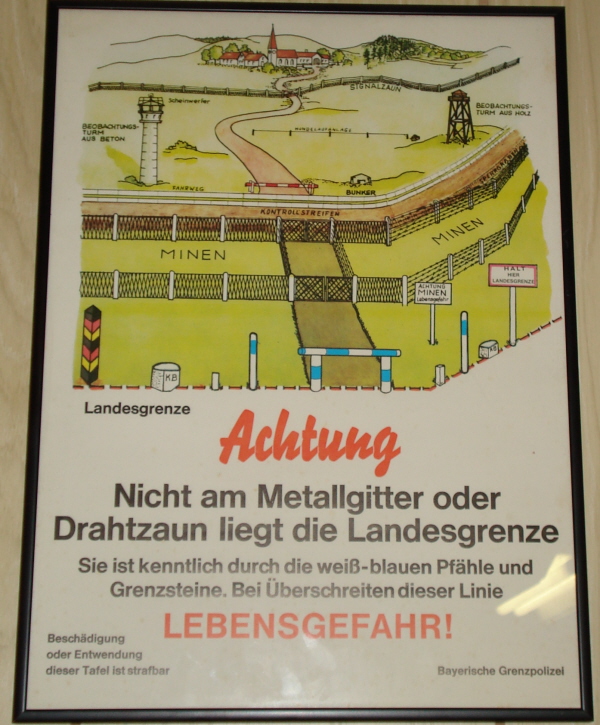 |
|
| |
Bavarian Border Police Grenz Tafel that provided the basic form for
the 2/11 ACR Border Certificate … --Stefanowicz |
|
With Pistol and Carbine We
Ride by Night to the Roar o’ Cannon - wait, we’re lost!
I guess it was the late
Spring of 1978 when the Eaglehorse squadron held its annual
right of passage for the new crop of lieutenants - the
Cavalry Lieutenant’s Night Ride. My particular recollection
is that this was held within a few days of departure to WTA
and was looked upon as more of a mid week disruption rather
than a miles of smiles event.
The course was laid out on
the forest trails and farm roads in the countryside
surrounding Bad Kissingen, primarily in the area north of
town but south of Wollbach. Various 1st Lts and
NCOs were tasked to monitor the military stakes stations
that were at each mobile orienteering stop. Paired with a
driver, each new Lt set off from Daley with map in hand.
Something like a ten minute delay separated each jeep and I
think they dispatched every other participant in the reverse
course order … otherwise we surely would have ended up nose
to tail - following each other into the darkness.
| |
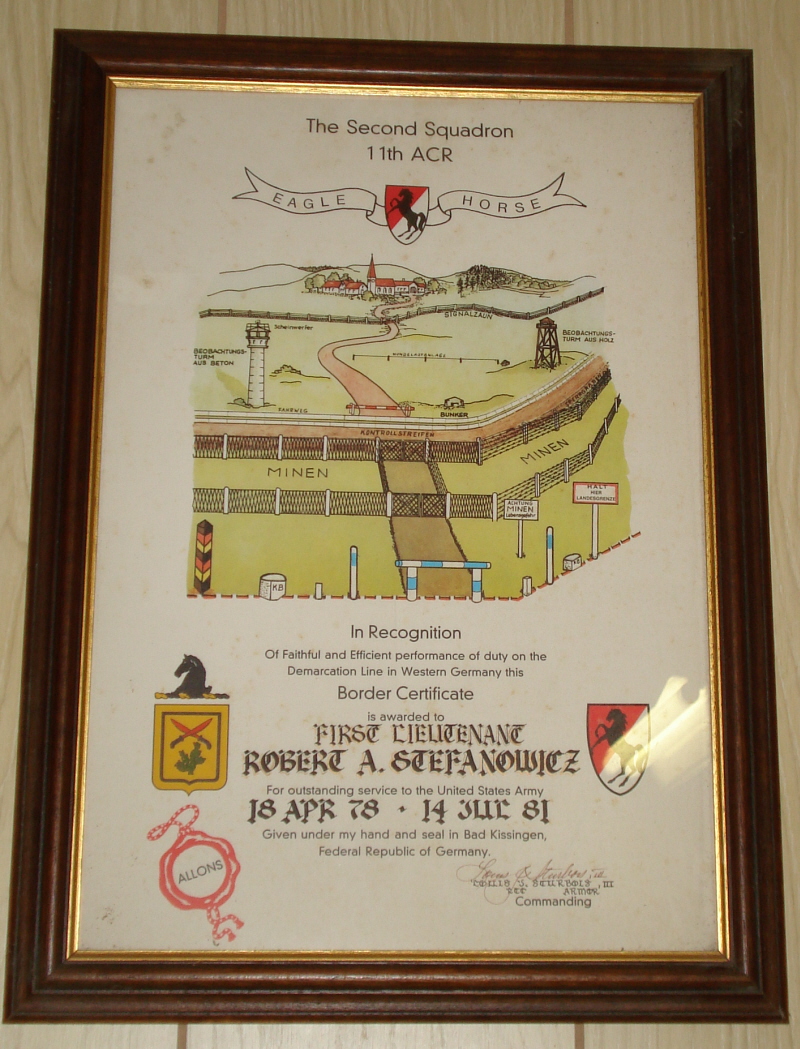 |
|
| |
… and how it was integrated into the early 1980s Eaglehorse
certificate. --Stefanowicz |
|
As you arrived at the skills
test station, a forest trail crossroad or similar minor map
feature, the station monitor logged the time and then one
faced a straight forward military stakes related task. Ted
Cheatham, my good friend from those early days, picks up the
story.
- - Everyone in the Orderly
Room looked at me in an odd way. What did I mean, that I
wanted to compete in the Cavalry Platoon Leader night ride
competition? You are not a cavalry officer, you are a field
artillery officer, Howitzer Battery 2/11 ACR.
| |
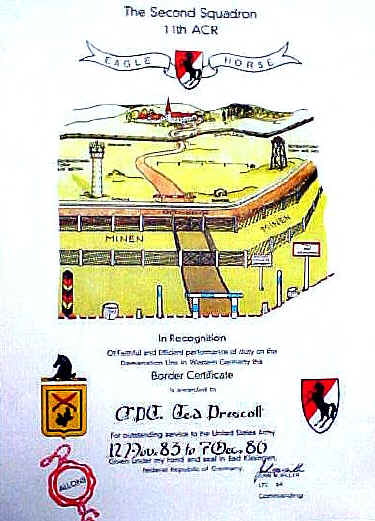 |
|
| |
Ted Prescott’s certificate as of 1986. --Ted Prescott |
|
My response was a simple
one. I lived and breathed the Cavalry. My best friends were
Cavalry. Should the time arise, my support of their
operations would be crucial. I trained to think like them
and understand their tactics (and did my best to keep up
with them drinking at the Fiddler’s Green). I was a Cavalry
Officer!
In trying to recall these
events, here are some of the memories that came to mind.
First, it was dark. I have always prided myself in my
ability to read a map and very seldom got lost. Finding most
of the locations was pretty easy except for one. We were
supposed to be tactical and once off the main roads, moved
along in black out.
| |
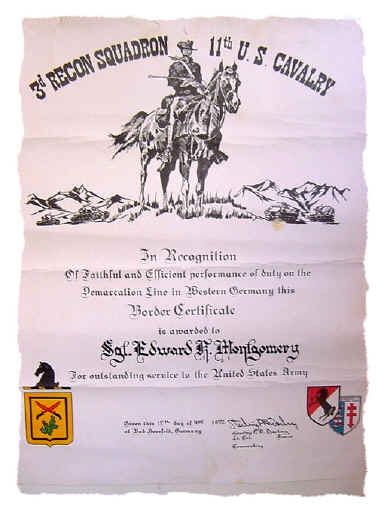 |
|
| |
Mid 1980s 3/11 ACR Border Certificate from Ted Prescott’s Grenzer
site. --Ted Prescott |
|
Now, I wish I could remember
the officer’s name who ran the .45 disassembly/assemble
station because he was a good man...and pretty darn sly. In
some areas if you got close, you could see lights of people
waiting for you...but not at the pistol station. This guy
was in black camo face paint just sitting there not saying a
word. You actually had to find him with a red lens
flashlight and I must have walked by him twice and he didn’t
say a word. To make it worse, he picked a location that was
off a trail with no specific terrain relief to be of much
use.
I used to orienteer in
college and knew how to get close. When we hit a known
intersection on the map, I tracked our distance by the
odometer which I converted to kilometers and that got us to
within a hundred feet or so. From there, it was Indian
tracking, gully walking, and a little luck. I understand a
few people never found him.
| |
 |
|
| |
3/11 ACR Certificate from the late 1980s as found at
www.grenzer.com
. --Ted Prescott |
|
So, now I arrived at the
station and have found him. He is sitting on a camp stool.
In front of him is a tarp on it is laid a .45 pistol. He
says something like, “Your job is to disassemble and
assemble this .45 cal pistol in the fasted time. Let me know
when you are ready and I will start the time. I will verify
it is fully disassembled before you can put it back
together.” Come on! We have all been here before. There are
two ways to take these things apart. One by the book and one
with speed. Realizing it was a competition, there was no
real decision on my part. I yanked the sucker apart.
| |
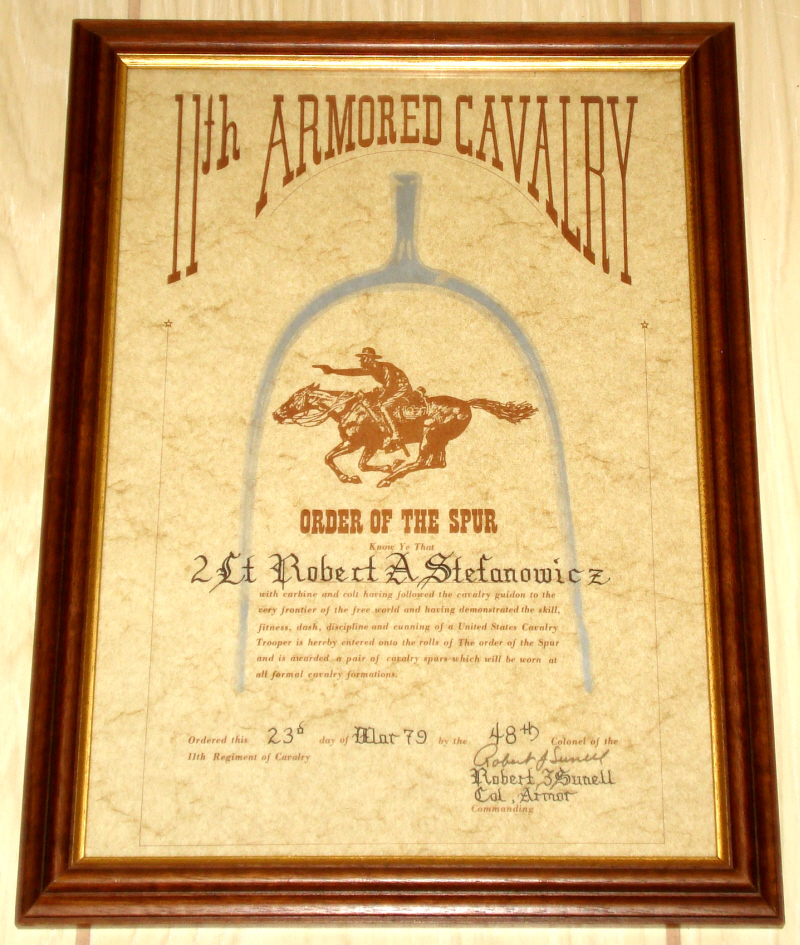 |
|
| |
11th ACR Order of the Spur certificate as of early 1980s.
--Stefanowicz |
|
Now, if you have ever
“yanked the sucker apart”, you know the risk of the spring
flying out to never, never land. Luckily for me, the time
was stopped because he could not verify it was apart because
the spring was not there. And, we had to find it in the
dark. Good news is, it took just a second or two to find it
and I zipped it back together with a rather impressive time.
Another stop required me to
call in Artillery Fire and adjust it onto target. As an
artillery officer, I would lose my butter bar if I could not
do this one. And, I probably taught a couple of you folks to
do this task as well.
How about a station on
headspace and timing of a .50 cal machine gun. This takes me
to probably the best part of being in the Cavalry as a field
artillery officer. As one of three or four officers in the
howitzer battery, we had to do everything that was done by
several dozen officers in a field artillery battalion. As
such, we were double duty and saw experience that our
counterparts never had a chance to try. One of my many extra
duties was arms room officer and the .50 cal was no problem
for me. As I traveled in my military career and visited
soldiers in the field, I was always amazed at the lack of
understanding of the .50 cal. This is a fine accurate weapon
if treated correctly. Of course in the cavalry and
mechanized units, this was a standard weapon. When I hit the
light infantry division, it was like a weapon from a UFO. I
cannot count the number of adhoc classes I gave soldiers on
this weapon that they were supposed to be the primary
defense of our perimeter.
| |
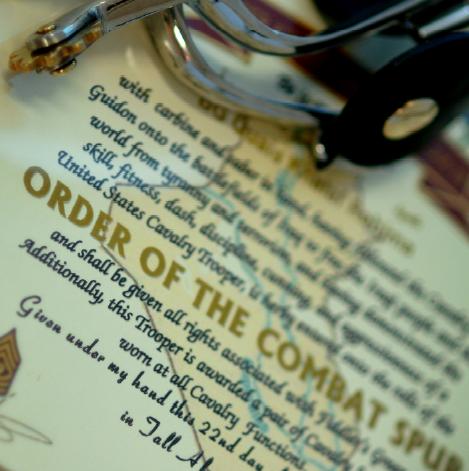 |
|
| |
Order of the Combat Spur graphic showing certificate and spurs
awarded to cavalry troopers deployed to Iraq |
|
My last stop of the evening
was to write an operations order. This one was to be graded
the next day. You were given specific parameters and a
mission to complete. From there you had a set amount of time
to generate an operations order. When I left the 2/11 ACR
and went to the FA officer advanced course, I was amazed at
the lack of understanding of my counterparts on how to plan
to support mobile combat arms operations. Anyway, I must
have had a good operations order.
As I look back on the
evening, I recall it as a fun little exercise, but the real
fun was being a part of a wonderful team of Cavalry officers
in 2/11 ACR. One more thing … when the travel times were
added up and the scores from the stations were computed … in
something I did not let my peers in BK forget for several
months … I had won the event. Sometime later, I had the
honor of representing the Eaglehorse at a similar Tournament
of Champions event at Fulda. I did not win but had a more
than respectable time and score. Howitzer Battery, Sir!! --
| |
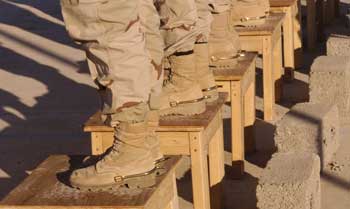 |
|
| |
Spur ceremony for troopers from the First Cavalry Division in Iraq. |
|
Order of the Spur and the
Army of 2008
Task -- condition --
standard … for some time now, it has been applied to the
Order of the Spur and the great news is that the honor is
now afforded to all troopers at all grades Army wide whose
units choose to uphold a cavalry tradition. The night ride
in many units has grown into an epic quest, a brutal two day
beast in comparison to the little ride that Ted Cheatham and
I experienced in 1978 through the woods above Bad Kissingen.
The basic standards are still up to the unit commander but
they certainly have become more demanding and success at
this task represents a significant achievement for any
junior enlisted trooper, NCO or officer. Here is a typical
example from one unit of the absolute minimum requirements:
- Service in the
Battalion / Squadron for at least 180 days.